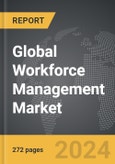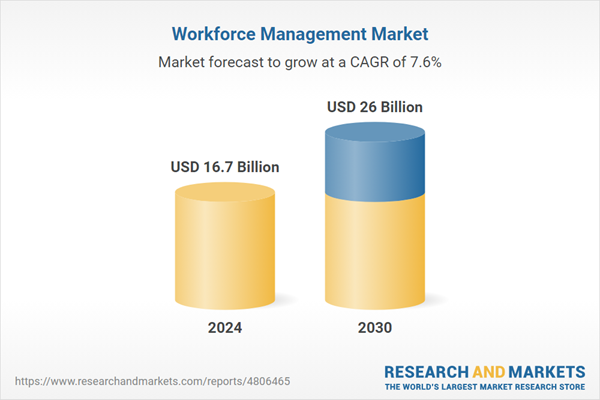The global market for Workforce Management was valued at US$16.7 Billion in 2024 and is projected to reach US$26.0 Billion by 2030, growing at a CAGR of 7.6% from 2024 to 2030. This comprehensive report provides an in-depth analysis of market trends, drivers, and forecasts, helping you make informed business decisions. The report includes the most recent global tariff developments and how they impact the Workforce Management market.
Segments: Component (Solutions, Services); Deployment (On-Premise Deployment, Cloud); End-Use (BFSI, Manufacturing, Transportation & Logistics, Retail, Healthcare & Life Sciences, Telecom, Energy & Utilities, Government, Other End-Uses).
Geographic Regions/Countries: World; United States; Canada; Japan; China; Europe (France; Germany; Italy; United Kingdom; and Rest of Europe); Asia-Pacific; Rest of World.
The analysts continuously track trade developments worldwide, drawing insights from leading global economists and over 200 industry and policy institutions, including think tanks, trade organizations, and national economic advisory bodies. This intelligence is integrated into forecasting models to provide timely, data-driven analysis of emerging risks and opportunities.
Global Workforce Management Market - Key Trends & Drivers Summarized
What is Fueling the Demand for Workforce Management Solutions?
The workforce management (WFM) market has evolved significantly in recent years, driven by the need for organizations to enhance productivity, reduce operational costs, and manage an increasingly diverse and remote workforce. The adoption of WFM solutions spans various sectors, including retail, healthcare, manufacturing, and IT, all aiming to streamline employee scheduling, time tracking, and attendance management. As businesses strive for operational efficiency in an unpredictable economic environment, the importance of managing human resources effectively has never been greater. Workforce management tools, enhanced with artificial intelligence and machine learning capabilities, provide data-driven insights for better decision-making and workforce optimization, resulting in improved employee engagement and retention rates.How Are Technological Innovations Reshaping Workforce Management?
Technological advancements have been pivotal in reshaping the landscape of workforce management. Cloud-based WFM solutions, in particular, are gaining traction due to their scalability, flexibility, and lower upfront costs. These solutions allow organizations to easily manage their workforce remotely, a trend that has accelerated due to the COVID-19 pandemic and the shift towards hybrid work models. Furthermore, the integration of advanced analytics and AI in workforce management tools has enabled companies to predict workforce trends, optimize labor costs, and improve productivity. The rise of mobile WFM applications has also empowered employees by providing them with easy access to schedules, shift swaps, and time-off requests, fostering a more collaborative and responsive work environment.Why Are Different Sectors Adopting Workforce Management Solutions?
The adoption of workforce management solutions varies across sectors, each driven by unique operational needs and challenges. In the healthcare sector, for example, WFM systems are crucial for ensuring optimal staff allocation and compliance with labor laws, directly impacting patient care quality. Retail and hospitality industries, where labor costs constitute a significant portion of operational expenses, utilize WFM tools to minimize overstaffing or understaffing, enhancing customer service during peak times. Meanwhile, in manufacturing and logistics, workforce management systems are integral to maintaining productivity and safety standards. The growing trend of remote and hybrid work models across all sectors is also leading to an increased demand for robust WFM systems that can effectively manage a geographically dispersed workforce.The Growth in the Workforce Management Market is Driven by Several Factors
The growth in the workforce management market is driven by several factors, including the increasing need for workforce optimization, the adoption of cloud-based solutions, and the integration of AI and analytics in human resource processes. The shift towards remote and hybrid work environments has necessitated more sophisticated WFM systems that can manage diverse workforce needs effectively. Additionally, the focus on employee experience and engagement has encouraged organizations to invest in mobile WFM applications that offer convenience and transparency to employees. The pressure to comply with complex labor regulations across different regions is another significant driver, prompting businesses to adopt advanced WFM tools to avoid compliance-related risks and financial penalties. As companies increasingly recognize the strategic value of workforce management, the market is poised for robust growth in the coming years.Report Scope
The report analyzes the Workforce Management market, presented in terms of units. The analysis covers the key segments and geographic regions outlined below.Segments: Component (Solutions, Services); Deployment (On-Premise Deployment, Cloud); End-Use (BFSI, Manufacturing, Transportation & Logistics, Retail, Healthcare & Life Sciences, Telecom, Energy & Utilities, Government, Other End-Uses).
Geographic Regions/Countries: World; United States; Canada; Japan; China; Europe (France; Germany; Italy; United Kingdom; and Rest of Europe); Asia-Pacific; Rest of World.
Key Insights:
- Market Growth: Understand the significant growth trajectory of the Solutions segment, which is expected to reach US$18.3 Billion by 2030 with a CAGR of a 7.3%. The Services segment is also set to grow at 8.6% CAGR over the analysis period.
- Regional Analysis: Gain insights into the U.S. market, valued at $4.5 Billion in 2024, and China, forecasted to grow at an impressive 7.2% CAGR to reach $4.1 Billion by 2030. Discover growth trends in other key regions, including Japan, Canada, Germany, and the Asia-Pacific.
Why You Should Buy This Report:
- Detailed Market Analysis: Access a thorough analysis of the Global Workforce Management Market, covering all major geographic regions and market segments.
- Competitive Insights: Get an overview of the competitive landscape, including the market presence of major players across different geographies.
- Future Trends and Drivers: Understand the key trends and drivers shaping the future of the Global Workforce Management Market.
- Actionable Insights: Benefit from actionable insights that can help you identify new revenue opportunities and make strategic business decisions.
Key Questions Answered:
- How is the Global Workforce Management Market expected to evolve by 2030?
- What are the main drivers and restraints affecting the market?
- Which market segments will grow the most over the forecast period?
- How will market shares for different regions and segments change by 2030?
- Who are the leading players in the market, and what are their prospects?
Report Features:
- Comprehensive Market Data: Independent analysis of annual sales and market forecasts in US$ Million from 2024 to 2030.
- In-Depth Regional Analysis: Detailed insights into key markets, including the U.S., China, Japan, Canada, Europe, Asia-Pacific, Latin America, Middle East, and Africa.
- Company Profiles: Coverage of players such as ADP LLC, IBM Corporation, Kronos, Inc., Oracle Corporation, SAP SE and more.
- Complimentary Updates: Receive free report updates for one year to keep you informed of the latest market developments.
Some of the 193 companies featured in this Workforce Management market report include:
- ADP LLC
- IBM Corporation
- Kronos, Inc.
- Oracle Corporation
- SAP SE
- Workday, Inc.
- WorkForce Software
Tariff Impact Analysis: Key Insights for 2025
Global tariff negotiations across 180+ countries are reshaping supply chains, costs, and competitiveness. This report reflects the latest developments as of April 2025 and incorporates forward-looking insights into the market outlook.The analysts continuously track trade developments worldwide, drawing insights from leading global economists and over 200 industry and policy institutions, including think tanks, trade organizations, and national economic advisory bodies. This intelligence is integrated into forecasting models to provide timely, data-driven analysis of emerging risks and opportunities.
What’s Included in This Edition:
- Tariff-adjusted market forecasts by region and segment
- Analysis of cost and supply chain implications by sourcing and trade exposure
- Strategic insights into geographic shifts
Buyers receive a free July 2025 update with:
- Finalized tariff impacts and new trade agreement effects
- Updated projections reflecting global sourcing and cost shifts
- Expanded country-specific coverage across the industry
Table of Contents
I. METHODOLOGYII. EXECUTIVE SUMMARY2. FOCUS ON SELECT PLAYERSIII. MARKET ANALYSISCANADAITALYREST OF EUROPEREST OF WORLDIV. COMPETITION
1. MARKET OVERVIEW
3. MARKET TRENDS & DRIVERS
4. GLOBAL MARKET PERSPECTIVE
UNITED STATES
JAPAN
CHINA
EUROPE
FRANCE
GERMANY
UNITED KINGDOM
ASIA-PACIFIC
Companies Mentioned (Partial List)
A selection of companies mentioned in this report includes, but is not limited to:
- ADP LLC
- IBM Corporation
- Kronos, Inc.
- Oracle Corporation
- SAP SE
- Workday, Inc.
- WorkForce Software
Table Information
| Report Attribute | Details |
|---|---|
| No. of Pages | 272 |
| Published | April 2025 |
| Forecast Period | 2024 - 2030 |
| Estimated Market Value ( USD | $ 16.7 Billion |
| Forecasted Market Value ( USD | $ 26 Billion |
| Compound Annual Growth Rate | 7.6% |
| Regions Covered | Global |









